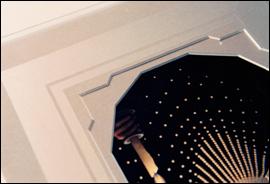 Photo 1
Photo 1
The character of a line may be straight; angular creating shape; or created from another material. Laminating film has been used as a double panel design using line.
Line is the most fundamental element of design. It begins with a dot or point of concentration and then by an extension from that point it becomes a line. It manifests itself from many varied beginnings such as doodles on paper to natural phenomenon such as the horizon. Line extends into symbolism when applied to Nature. The thin branches of a tree's silhouette, the veins within a leaf or the layering of a shale rock wall all illustrate line within Nature.
Subjective and Objective Line
They (lines) are a graphic device used to function symbolically in literary and artistic expression. Though best described in art it is the most powerful basis for most of our creative stimulus. Lines may be either subjective as in the subject of or for communication, or objective as in the object of physical art. Subjective lines are those modified for communication to evoke emotional states and responses as in calligraphy and letterform expression, the written form.
Objective lines describe measurements and surface characteristics or decoration, as in picture framing. Line enriches a surface without denying the essential flatness of the nature of the artwork. Although we see "line" in all of Nature, it is (in its purist state) a man-made invention, an abstracted definition developed for the simplification of visual facts and symbolizing graphic ideas. This remains true whether discussing lines as subjective for communication or objective for surface decoration.
Line in Framing
Since a line is a path of a moving point or mark, made by some type of tool or instrument, drawn across a surface, made visible by contrast it is fairly easy to translate this into framing design. Thick, thin, dark, light, straight, curving...all lines stimulate a visual response and therefore create movement. This eye manipulation may be deliberately stimulated by a framer through his use of numerous line designs including ruling pen or embossed, painted bevels and panel designs. The character of a line, the part that helps stimulate additional emotional responses, is also controlled by these various decorative interpretations (photo 1).
 Photo 1
Photo 1
The character of a line may be straight; angular creating shape; or created from another material. Laminating film has been used as a double panel design using line.
Wide, pastel tinted, dry pigment panels may appear extremely soft, romantic and feminine while a black ruling pen line is capable of taking on a much harder, aggressive, masculine interpretation (photo 2).
 Photo 2
Photo 2
Embossed lines with feminine hand painted panel decoration.
Successful line designs may bleed off a page or out of a frame yet still draw the viewer back into the frame. They are capable of awakening emotional responses in a viewer by control of focal point and eye movement by the very use of line variety and placement. Straight lines (such as the embossed lines in photo 2) travel only in one direction and stimulate a designated emotional response depending upon their direction, as in a passive horizontal, inspirational vertical or agitated diagonal. Curved lines (photo 3) gradually change direction and are graceful and soothing yet may evoke instability depending upon other integrated elements. Angular lines have abrupt changes of direction and often stimulate excitement, confusion or challenge.
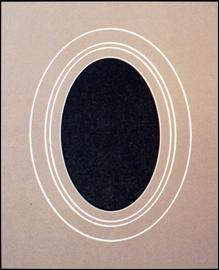 Photo 3
Photo 3
There are three curved lines v-groove lines in this oval window mat.
Line vs. Other Elements
By designating a division, lines create spaces and by enclosing an area, a line's edge creates shape (photo 4). Although often unrelated to framing per se, a line in art becomes a contour when it creates a 2-dimensional boundary creating a shape; a form when it is used to visualize a 3-dimensional image such as in a sculpture; and as texture when multiple lines are executed in close proximity to one another.
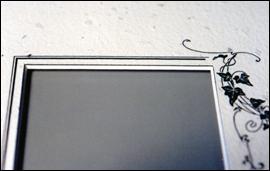 Photo 4
Photo 4
When lines come together they enclose an area and become shapes or spaces. A surface tiered mat shows additional lines at the top of the window bevel too.
Lines almost always imply other elements such as shape, space, form and texture as designated by their application, and they have the power to emphasize or lead the viewer's eye. The intricacy of design will become more evident as additional principles are discussed, and emphasis will be covered as a separate principle. Though design principles are all individually titled and defined, they all intricately weave together into a meshed unit for they often cross over into other categories, this is how the entire concept of a "unified" design works. Every portion relates and inter-relates to every other part and everything going on within a framing design should be happening for a reason.
The Givens
When interpreting the use of line as a principle of picture framing design you must begin with a given set of standards. A designer must be capable of limiting the use of design principles, a total of both the elements and factors, as a basis for the structure of design control. Ultimately what is required is a clearer understanding of what goes into a good design and what needs to be kept out!
By establishing the required givens, those items required to frame a piece of art, and an understanding of the individual design principles (line, color, texture...) one may literally add up the number of visual design activities within a framed presentation. By limiting the principles to 3-5 items the design quite often will remain strong, tasteful and understated, thus enhancing the art as it should and not overdoing the design!
The "givens" in framing include an understated traditional frame and single mat with a single rectangular opening of traditional border widths. Anything done in addition to alter the basic visual presentation then becomes a specific stimulation of an additional design principle, and these once again work consistency best when held in the range of 3-5 principles per presentation.
Pure Design Element
As already noted, there are a great number of line possibilities in relation to framing design. The most pure use of line as a design element is a monochromatic double mat (white on white), same color core v-groove or embossed line, a design in which no other elements are initiated...using only line as an attention getter or visual accent. Controlling the use of line only must exclude the introduction of color (which would then be a second element), but does allow for numerous layers of same colored mats to be used within the design. Each line does not become a new separate element, a double, triple, quadruple monochromatic mat unit or simply a double mat with a v-groove all count as a single design element as long as a designer color core board has not deliberately been used as a color accent.
Museum boards with the same color core (Strathmore, Rising), white core conservation boards (Alphamat, Rag Mat, UltiMat) may all be considered in a pure line design, they fit in as givens.
Additional Elements
Once the concept of pure line as a single element is understood a line may then have a color added to expand upon it's design potential. Since 3-5 principles is our goal, the addition of color to line is quite acceptable and opens up the ultimate in surface line decoration as mentioned earlier. Now by varying line widths and colors more dramatic accents are possible (photo 5).
 Photo 5
Photo 5
Lines are created with under tiered bevels, liner mat and v-groove, but they are all still lines. Line, color and intensity (with the added spacer) are the principles used here.
Besides color, the character of the line from a framing point of view may be altered by the integration of multiple medias such as sewn silk threads (photo 6), marbled papers (photo 7) and contempo panels with laminating films. As each new item is used to create an illusion of line additional elements are inadvertently integrated and will need to be counted towards the final total of principles counted. Silk threads may represent line and color, laminating films integrate line and texture, but one single strip of surface marble paper counts as line, color and texture.
 Photo 6
Photo 6
Silk and metallic threads have been sewn into the window mat as delicate lines using line and color.
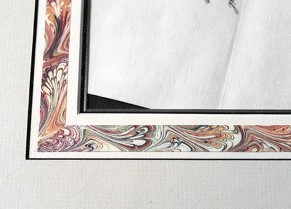 Photo 7
Photo 7
Marbled paper on the liner middle mat.
It's not at all as involved and confusing as it sounds, simply go back to the basics and really see what you are looking at. Pay attention to the fact a surface decorative panel is firstly "a line", though it's character may be wide or narrow, pastel dry pigment or marbled paper, it begins as a line prior to it being a color, texture or combination.
Designing with pure line is clean, classy and simple, though perhaps not overly profit making, but then again isn't a Brian Wolf hand carved mat simply a series of curved lines creating a shape? (photo 8) Oh yea, so that isn't pure line, its line and shape...but there's more money in it too.
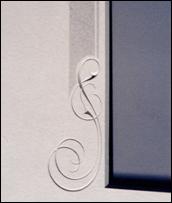 Photo 8
Photo 8
A dry pigment surface panel decoration creates a soft line while the carving illustrates the creation of curved lines developing a shape.
Good vs. Bad Line
In a good design if you can energize the line it will animate the art in relation to the entire design bringing the whole of the image to life. The eye movement is activated from the art image to the line decoration but ultimately back to the image, truly enhancing the art. A good design is technically well executed, playing off the period and style of the artwork as in a traditional French mat on a antique botanical print.
In a bad design, lines become isolated with no organic relationship or meaning to the whole of the art and the design dies. This can happen through poorly placed v-grooves, too many mat layers, or technically drawing attention away from the art through corner overcuts or non-parallel v-groove lines the result of a badly calibrated mat cutter.
Line in Review
Try not to underestimate the power of the line. Embossed lines, v-grooves and monochromatic multiple mats may either showcase the art or leave it flat. Think about appropriateness in your design, everything must be there for a reason, not simply to up the price of the framing job, and never lose sight of the aesthetics and beauty of the line in its purest state. The bottom line states "it's all up to you" to determine the correct presentation.
END
Copyright © 1994 Chris A Paschke
For more articles on mounting basics look under the mounting section in Articles by Subject.
Additional information on all types of mounting is found in:
The Mounting and Laminating Handbook, Second Edition, 2002,
The Mounting And Laminating Handbook, Third Edition, 2008 and
Creative Mounting, Wrapping, And Laminating, 2000 will teach you everything you need to know about getting the most from your dry mount equipment and materials as an innovative frame designer.
All books are available from Designs Ink Publishing through this website.
Chris A Paschke, CPF GCF
Designs Ink
Designs Ink Publishing
785 Tucker Road, Suite G-183
Tehachapi, CA 93561
P 661-821-2188
chris@designsinkart.com